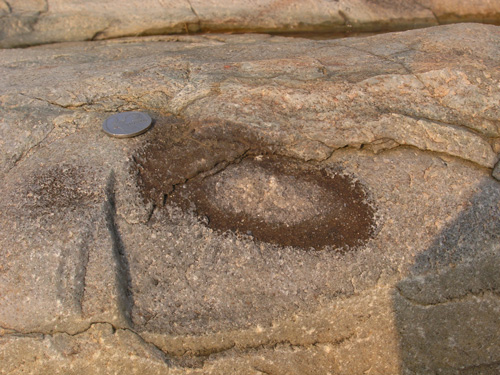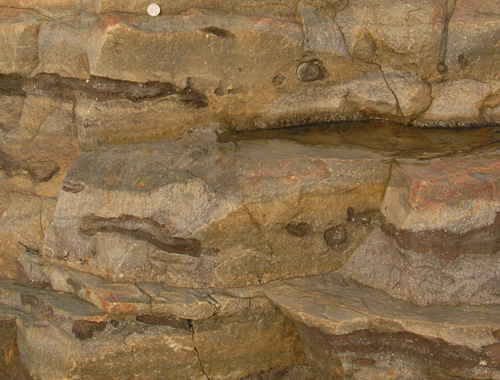I hadn’t forgotten about the mystery feature that I posted more than a fortnight ago, and I certainly wasn’t intending to leave it this long. Perhaps it’s the fact that in this case, as I said at the time, I don’t have a definitive answer to give you.

Congratulations to those who identified the 2 Rand coin acting as my scale bar. As for the thing next to it, the consensus seemed to be that it represented some sort of concretion: a geological pearl, formed by minerals accreting around a speck of organic matter or some other chemically distinct impurity during compaction and lithification of sediments. The problem with this interpretation is that the stuff inside the black rim of this concretion (quartzite) is indistinguishable from the stuff outside it (also quartzite). It’s only the rim itself which appears to be enriched in iron minerals. You can sometimes get such ring-like alteration associated with filled-in animal burrows, but given that we are again looking at the Archean sandstones that I visited a couple of months ago, we’re a couple of billion years too early for that…
In a wider view of the outcrop, you can see that features with a similar structure are found in distinct layers, albeit somewhat intermittent and fragmented ones


My initial thought was that these layers might be more remnants of Archean microbial mats, similar to the ones that are found stratigraphically below this section; the difference being that here we have a higher energy environment that has disrupted them more. In this case, the first photo would represent a small mat fragment that has been torn away by strong currents and curled up on itself, trapping some sediment within it as it did so (the Lost Geologist was clearly thinking along similar lines when he suggested it was an armoured mudball). Looking more closely, though, I’m not so sure, because the layers themselves also consist of altered rims surrounding a relatively unaltered core, rather than the single layer you’d expect if it was a preserved bacterial mat. Perhaps, then, Christie is right and this represents some sort of alteration at the edge of channels followed by pore water flowing through the sediments following deposition. Quite what would cause such preferential fluid flow through the rock is unclear though, possibly because the alteration to quartzite has removed any evidence for large variations in porosity in the original sediments.
Feel free to throw in a further R2 if you’re inspired.



Comments (3)